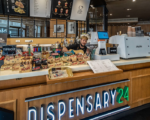They’re not your stereotypical stoners. They’re grandmothers with arthritis, veterans with PTSD, and retirees struggling to sleep. And according to a new wave of research, they’re lighting up at unprecedented rates.
A fresh study out this month shows cannabis use among Americans aged 65 and older has skyrocketed in the last five years. While the increase isn’t exactly news to people working in dispensaries or geriatric health, it does challenge long-held assumptions about who’s really fuelling the green rush.
Weed isn’t just for the young—and the numbers prove it
Back in 2007, fewer than 1% of seniors reported using cannabis. Fast forward to 2024, and that number has surged past 8%, according to data from the National Survey on Drug Use and Health.
That’s not just a little jump—it’s an 800% increase.
One reason? Legalisation. As more states have rolled out medical and recreational programmes, access has expanded dramatically. Seniors, many of whom previously viewed marijuana with suspicion, are now curious—some even eager.
The stigma is shrinking, slowly but surely.

Chronic pain, meet chronic relief
What’s driving the shift? Simple: pain. And a deep dissatisfaction with the side effects of traditional pharmaceuticals.
Margaret, a 72-year-old former librarian from Oregon, says cannabis is the only thing that lets her sleep through the night. “I’ve tried melatonin, Ambien, even wine,” she said. “But nothing works quite like a little gummy before bed.”
Doctors say she’s not alone. Among senior users:
-
The most common reason cited is chronic pain
-
Anxiety and sleep issues follow closely behind
-
Some even report using it to reduce opioid dependency
“There’s growing clinical evidence that cannabinoids, especially CBD, may offer benefits with fewer side effects than opioids,” said Dr. Hannah Simons, a geriatrician in San Francisco. “Older patients are often the most medication-sensitive, so alternatives are important.”
Peer-to-peer pot advice? It’s a thing.
It turns out seniors are talking to each other—a lot—about weed.
Unlike younger users who get their cannabis cues from TikTok or Reddit, older folks are more likely to learn from neighbours, book club friends, or even their adult children.
Sally Johnson, 69, started using cannabis after her bridge partner mentioned it helped her arthritis. “I was sceptical,” she said. “But then I tried her CBD cream. I could knit for hours without pain.”
Anecdotal, yes. But powerful.
These informal conversations—one friend helping another figure out dosage, brands, or whether edibles are better than vapes—are shaping a kind of underground network of senior cannabis users.
Not all sunshine and Sativas
Despite the boom, the senior-cannabis trend isn’t without its issues.
For one, most older adults still aren’t getting medical advice before using cannabis. That creates real risks, especially with drug interactions.
Dr. Eric Moretti, a pharmacologist at UCLA, warns: “Many seniors are on multiple medications. THC can interfere with blood thinners, heart medications, and more. And most dispensary staff aren’t trained to catch that.”
Then there’s dosing. Many older adults aren’t clear on how much to take—and unlike with pills, there’s no universal standard.
And while cannabis is helping some seniors cut back on opioids or benzodiazepines, for others, it becomes a new dependency.
One-sentence paragraph: It’s not a magic cure, and experts stress caution.
What’s hot: Oils, gummies and low-dose everything
So what are seniors actually using? Dispensaries are starting to notice trends among their older clientele, and they’re responding with products that match.
Here’s a quick look at what’s flying off the shelves:
| Product Type | Why Seniors Like It |
|---|---|
| CBD creams | Easy application for joint pain |
| THC/CBD tinctures | Precise dosing, no smoking involved |
| Gummies (low-dose) | Tastes familiar, easy to control effects |
| Capsules | Feels like taking a regular supplement |
| Vape pens (low THC) | Fast relief without combustion |
Many prefer starting with a 1:1 ratio of THC to CBD, easing into the effects without getting too “high.” That balance is especially important for seniors who want pain relief but still need to, say, walk the dog or manage appointments.
States take note—but are laws keeping up?
As more older Americans light up, lawmakers are being forced to re-evaluate both medical cannabis policies and education efforts.
Florida, with one of the highest populations of retirees, saw a 14% rise in senior medical cannabis registrations last year alone. Yet access to senior-specific education is lagging behind.
A cannabis nurse educator in Tampa, Lisa Howard, says, “I get calls every week from seniors who were told to ‘go to the dispensary and ask them.’ That’s not care. That’s outsourcing responsibility.”
She wants to see more clinics offer integrated services—especially as cannabis use starts to blend into everyday senior care.
Right now, it’s often a grey area. Medicare still doesn’t cover cannabis, even medically prescribed. Seniors are paying out-of-pocket, navigating a patchwork of state laws, and receiving mixed messages from their GPs.
The bottom line? Cannabis isn’t fringe anymore
It’s not just a trend. It’s a cultural shift.
Seniors who once saw marijuana as taboo are now its unexpected champions. They’re sharing advice, experimenting cautiously, and—perhaps most importantly—feeling heard.
As 75-year-old Robert from Arizona put it: “It’s not about getting high. It’s about getting through the day without hurting.”
And if that means sipping a THC-infused tea while reading the morning paper? So be it.
Maria Garcia is an award-winning author who excels in creating engaging cannabis-centric articles that captivate audiences. Her versatile writing style allows her to cover a wide range of topics within the cannabis space, from advocacy and social justice to product reviews and lifestyle features. Maria’s dedication to promoting education and awareness about cannabis shines through in her thoughtfully curated content that resonates with both seasoned enthusiasts and newcomers alike.








